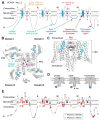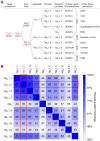Progress in Understanding and Treating SCN2A-Mediated Disorders
- PMID: 29691040
- PMCID: PMC6015533
- DOI: 10.1016/j.tins.2018.03.011
Progress in Understanding and Treating SCN2A-Mediated Disorders
Abstract
Advances in gene discovery for neurodevelopmental disorders have identified SCN2A dysfunction as a leading cause of infantile seizures, autism spectrum disorder, and intellectual disability. SCN2A encodes the neuronal sodium channel NaV1.2. Functional assays demonstrate strong correlation between genotype and phenotype. This insight can help guide therapeutic decisions and raises the possibility that ligands that selectively enhance or diminish channel function may improve symptoms. The well-defined function of sodium channels makes SCN2A an important test case for investigating the neurobiology of neurodevelopmental disorders more generally. Here, we discuss the progress made, through the concerted efforts of a diverse group of academic and industry scientists as well as policy advocates, in understanding and treating SCN2A-related disorders.
Keywords: Na(V)1.2; autism spectrum disorder; developmental delay; epilepsy; intellectual disability; neurodevelopment; neurodevelopmental disorder; sodium channel.
Copyright © 2018 Elsevier Ltd. All rights reserved.
Figures



References
-
- Nagy E, Maquat LE. A rule for termination-codon position within intron-containing genes: when nonsense affects RNA abundance. Trends Biochem Sci. 1998;23:198–199. - PubMed
-
- Kasai N, et al. Genomic structures of SCN2A and SCN3A - Candidate genes for deafness at the DFNA16 locus. Gene. 2001;264:113–122. - PubMed
-
- Gazina EV, et al. “Neonatal” Nav1.2 reduces neuronal excitability and affects seizure susceptibility and behaviour. Hum Mol Genet. 2015;24:1457–1468. - PubMed
-
- De Lera Ruiz M, Kraus RL. Voltage-Gated Sodium Channels: Structure, Function, Pharmacology, and Clinical Indications. J Med Chem. 2015;58:7093–7118. - PubMed
Publication types
MeSH terms
Substances
Grants and funding
LinkOut - more resources
Full Text Sources
Other Literature Sources

